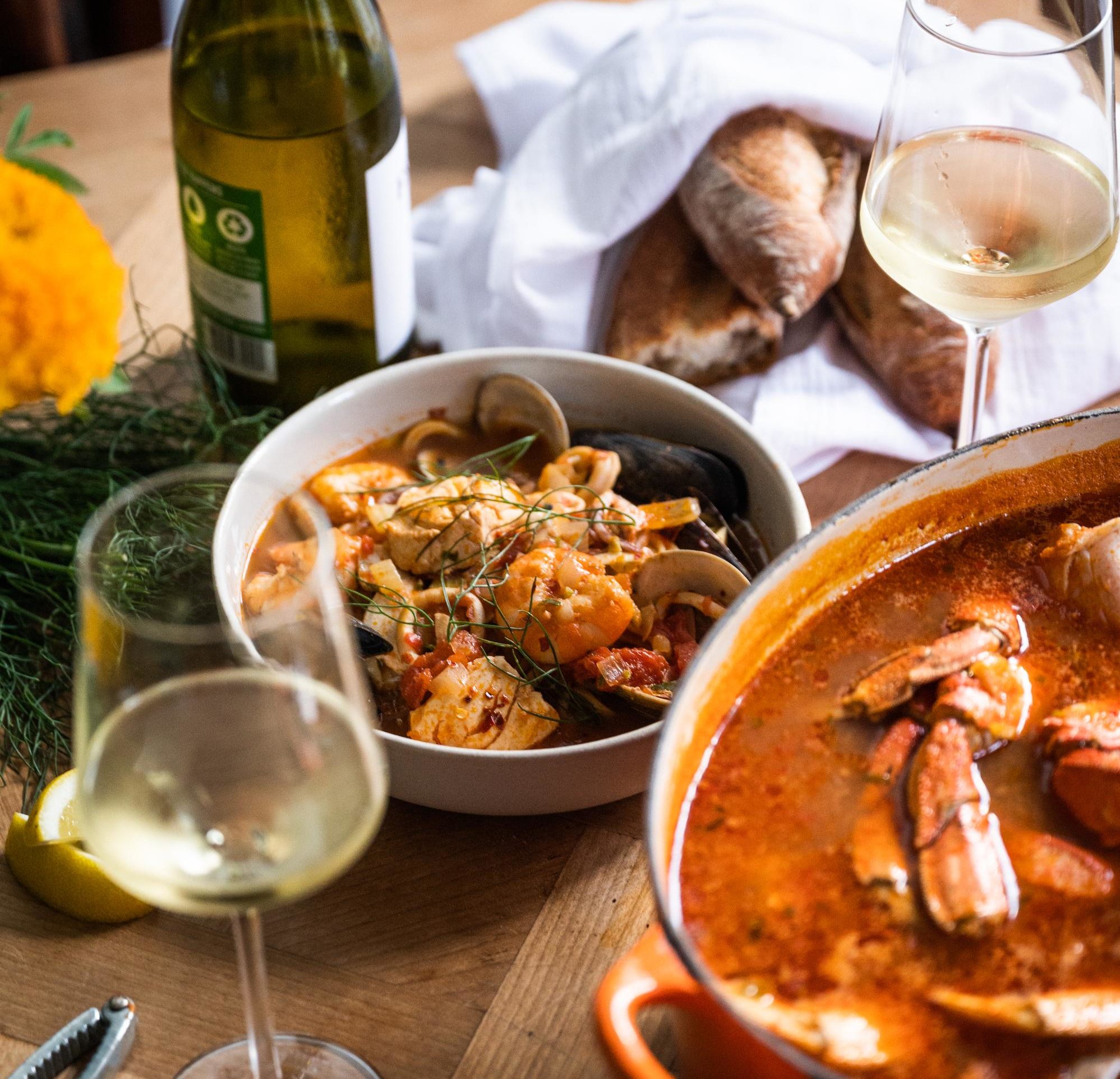‹ Back to Recipes


Cioppino over Pasta
Cioppino was developed in the late 1800s by fishermen in the North Beach area of San Francisco. If a fisherman came back from a day at sea without any fish, he would walk down the port with a pot asking his fellow fisherman to “chip in” some of their haul. The most common way to cook up the resulting assortment of seafood was to a tomato-based stew - now known as Cioppino. Even today, the type of seafood used in Cioppino often varies but it always features a tomato-based broth and spicy peppers - with lots of locally grown garlic and wine. California Chardonnay or California Dolcetto are perfect pairings for this iconic California dish.
Pairs With


Ingredients
- ¼ cup (113g) extra-virgin olive oil
- 1 yellow onion, finely diced
- 2 shallots, diced
- 1 fennel head, trimmed (reserve fronds), finely diced
- 2 (4g) teaspoons kosher salt, plus more for the pasta
- ½ teaspoon (.8g) red pepper or Calabrian chili flakes
- 6 cloves garlic, minced
- 3 tablespoons (42g) tomato paste
- 1 28-oz. (794g) can whole peeled tomatoes, crushed by hand or using a potato masher
- 6 cups (1,464g) seafood stock
- 1 ½ cups (359g) dry white wine
- 2 fresh bay leaves
- 1 lb (454g) mussels, de-bearded and rinsed
- 1 dozen littleneck clams, cleaned
- 12 oz. (340g) cleaned squid bodies and tentacles, bodies cut crosswise into 1/2-inch rings
- 1 lb. (454g) halibut or similar firm-fleshed fish, cut into 2-inch pieces
- 1 lb. (454g) 16-20 count shrimp, shelled and deveined
- 8 oz. (227g) lump crabmeat
- 1 lb. (454g) dried fettuccine
- 1 lemon, cut into wedges
- Sourdough bread to serve
Instructions
- In a large Dutch oven or stockpot, warm the oil over medium heat. Sauté the onion, shallots, and fennel for 10 minutes, or until the onion is translucent. Season with salt and chili flakes. Add the garlic and continue cooking for 2 minutes.
- Next, stir in the tomato paste until it’s incorporated, then add the tomatoes with their juices. Add the seafood stock, wine, and bay leaves, then bring to a low boil. Reduce the heat to medium-low, cover, and simmer for at least 30 minutes, until the flavors blend. Season with additional salt to taste.
- Meanwhile, heavily salt a large, separate pot of water and bring to a boil over medium-high heat. Once the water is at a rolling boil, add the dried fettuccine and cook until al dente, about 12 minutes or as directed on the packaging. Drain the cooked pasta and set aside.
- Once the cioppino broth is ready, add the mussels and clams. Cover and cook until they begin to open, about 5 minutes. Next add the squid, fish, and shrimp. Simmer and stir gently until the fish is just cooked through, another 5 minutes or so. The clams and mussels should be completely open (discard any that haven’t opened). Season again with salt and chili flakes to taste.
- Serve the cioppino in bowls over the cooked fettuccine and garnish with the reserved fennel fronds, a wedge of lemon, and a piece of sourdough.
- Note:
- Clams and mussels often release grit and sand during the cooking process, especially if they are very fresh. One easy way to avoid gritty cioppino is to submerge the clams and mussels in a large bowl with plenty of water and a generous amount of kosher salt. Let sit for about 1 hour, or while you are preparing the cioppino broth. The saltwater allows them to purge the sand and grit. When it’s time to add them to the pot, drain and rinse well under fresh water.

Pairs With






